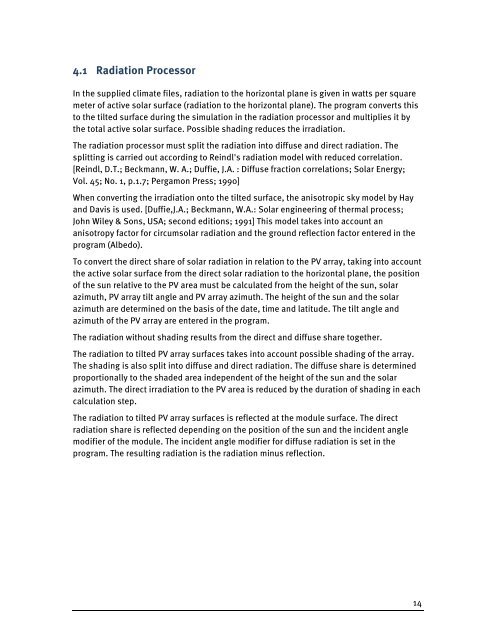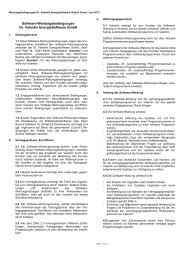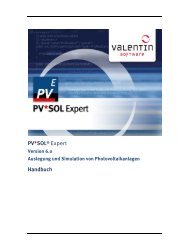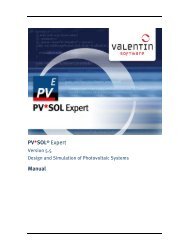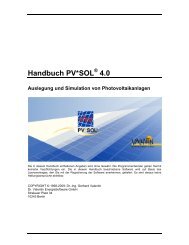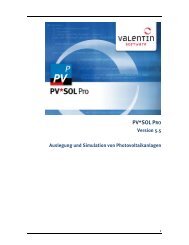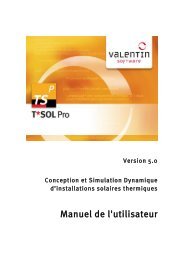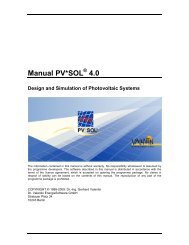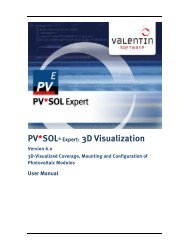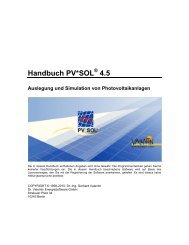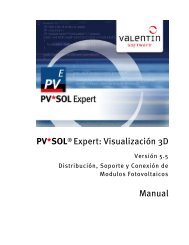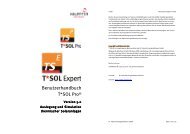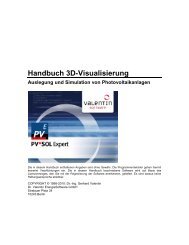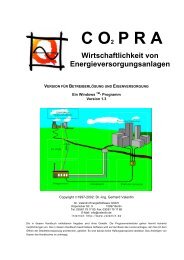PV*SOL Expert 6.0 - Manual - Valentin Software
PV*SOL Expert 6.0 - Manual - Valentin Software
PV*SOL Expert 6.0 - Manual - Valentin Software
Create successful ePaper yourself
Turn your PDF publications into a flip-book with our unique Google optimized e-Paper software.
4.1 Radiation Processor<br />
In the supplied climate files, radiation to the horizontal plane is given in watts per square<br />
meter of active solar surface (radiation to the horizontal plane). The program converts this<br />
to the tilted surface during the simulation in the radiation processor and multiplies it by<br />
the total active solar surface. Possible shading reduces the irradiation.<br />
The radiation processor must split the radiation into diffuse and direct radiation. The<br />
splitting is carried out according to Reindl's radiation model with reduced correlation.<br />
[Reindl, D.T.; Beckmann, W. A.; Duffie, J.A. : Diffuse fraction correlations; Solar Energy;<br />
Vol. 45; No. 1, p.1.7; Pergamon Press; 1990]<br />
When converting the irradiation onto the tilted surface, the anisotropic sky model by Hay<br />
and Davis is used. [Duffie,J.A.; Beckmann, W.A.: Solar engineering of thermal process;<br />
John Wiley & Sons, USA; second editions; 1991] This model takes into account an<br />
anisotropy factor for circumsolar radiation and the ground reflection factor entered in the<br />
program (Albedo).<br />
To convert the direct share of solar radiation in relation to the PV array, taking into account<br />
the active solar surface from the direct solar radiation to the horizontal plane, the position<br />
of the sun relative to the PV area must be calculated from the height of the sun, solar<br />
azimuth, PV array tilt angle and PV array azimuth. The height of the sun and the solar<br />
azimuth are determined on the basis of the date, time and latitude. The tilt angle and<br />
azimuth of the PV array are entered in the program.<br />
The radiation without shading results from the direct and diffuse share together.<br />
The radiation to tilted PV array surfaces takes into account possible shading of the array.<br />
The shading is also split into diffuse and direct radiation. The diffuse share is determined<br />
proportionally to the shaded area independent of the height of the sun and the solar<br />
azimuth. The direct irradiation to the PV area is reduced by the duration of shading in each<br />
calculation step.<br />
The radiation to tilted PV array surfaces is reflected at the module surface. The direct<br />
radiation share is reflected depending on the position of the sun and the incident angle<br />
modifier of the module. The incident angle modifier for diffuse radiation is set in the<br />
program. The resulting radiation is the radiation minus reflection.<br />
14


